Understanding the PROBLEM
Recent figures for rural India indicate that over 96% of children are enrolled in school. With almost all children in school, the critical question facing the country is – are children learning?
Since 2005, ASER - the Annual Status of Education Report - has attempted to answer this question. Facilitated by Pratham, ASER is a nation wide household survey that reaches a representative sample of children in every rural district in India. Over 600,000 children from more than 300,000 households are reached every year. A set of basic reading and arithmetic tasks are administered one on one to each sampled child. In 2018, ASER visited 596 districts across the country.
Sample: ASER reading and arithmetic tool

Over ten years of data from the Annual Status of Education Report (ASER) point to three key facts:
- First, at every grade level, basic learning levels are unacceptably low. The All India figures from ASER 2018 suggest that only about half of all children enrolled in Std V can read at least at Std II level. A similar proportion of children are able to do a two-digit subtraction problem (with borrowing) correctly. This suggests that at least half of all children in Std V in India need immediate support.
- Second, data from recent years shows small increases especially in lower grades, but much higher improvements are needed to bring children to up to the level of grade level expectations.
- Third, learning trajectories over time are flat. This suggests that if children do not acquire foundational skills in the primary school years, it is unlikely that they will pick them up later.

Going behind the headlines of ASER
Here is a table from ASER 2018 that shows reading levels for Std III to V. Not only do we see a large proportion of children at low levels of reading, but the variation in each grade is wide. For example: In Std V, while 50% of all children can read Std II level text (or even higher), the rest are not yet at Std II level. Close to 18% children are only able to recognize letters or yet to acquire that skill. 13% can read simple words but not sentences and another 19% are just about reading text at Std I level. This situation presents a huge challenge to any teacher. What should a teacher teach? And to whom? In a typical Indian classroom, the Std V teacher teaches from the Std V textbook and thus only the “top of the class” benefits from her teaching.
ASER 2018: % Children in primary school who can read at different levels
All India all rural districts:
Representative sample of all children from household survey
| ASER 2018: % Children in primary school who can read at different levels All India all rural districts: Representative sample of all children from household survey |
||||||
| Example | Cannot recognize letters yet | Can recognize letters but cannot read word | Can read words but cannot read sentences | Can read Std I level text but not higher | Can read Std II level text & maybe higher | Total |
| Std III | 12.1 | 22.6 | 20.8 | 17.3 | 27.2 | 100 |
| Std IV | 7.6 | 15.9 | 16.6 | 19.3 | 40.7 | 100 |
| Std V | 5.9 | 11.7 | 13.0 | 19.1 | 50.3 | 100 |
% Children in govt schools in Std III who can at least do subtraction: Selected States ASER 2018
The ASER 2018 graph on the left shows the proportion of Std III children enrolled in government schools who can at least do a numerical two digit subtraction problem with borrowing. (This kind of problem is usually found in Std II math textbooks in states). The All India figure indicates that approximately 21% of children can do this task correctly. However there is wide variation across the country with stats like Kerala, Himachal Pradesh or Punjab where more than 40% children can do this correctly to states like Rajasthan, Madhya Pradesh and Uttar Pradesh where this figure is lower than 15%. If we consider these levels as a proxy for the proportion of children who are at grade level in Std III, we can see that a substantial jump is required to help children get close to grade level expectations.
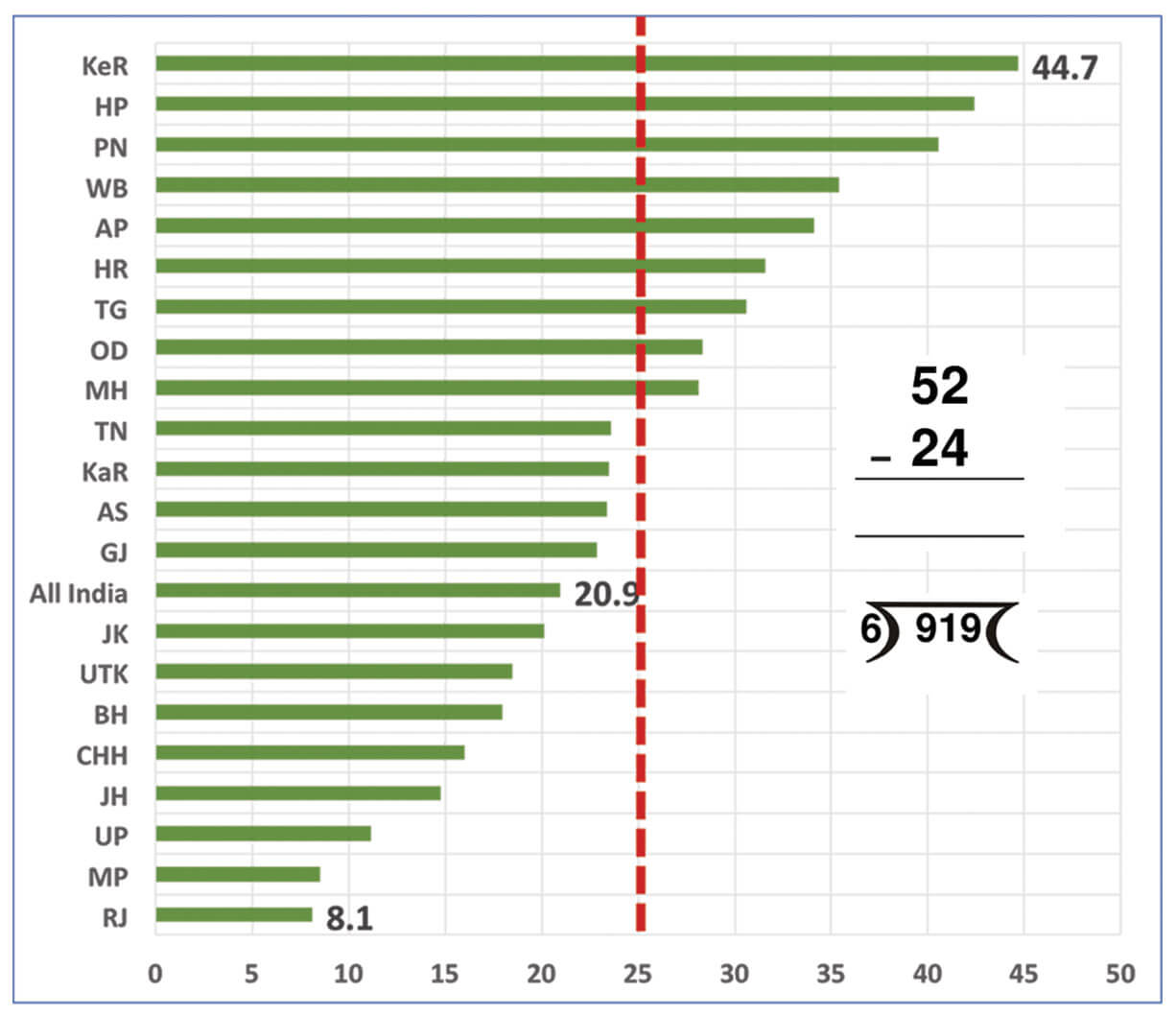
Guided Tour of Teaching at the Right Level (TaRL)
A possible solution for acquiring foundational
skills : Teaching at the Right Level
Over the last fifteen years, Pratham has evolved a solution called Teaching at the Right Level (TaRL) which enables children to acquire foundational skills, like reading and arithmetic quickly. Regardless of age or grade, teaching starts at the level of the child. This is what is meant by “Teaching at the Right level”. The TaRL method developed by Pratham was originally designed keeping in mind children who have already reached Std. III, IV or V but still have not acquired basic skills. The focus is on helping children with basic reading, understanding, expressing themselves as well as arithmetic skills. These are foundational building blocks that help a child to move forward. Studies have shown that once acquired these capabilities endure over time. TaRL is an effective and low-cost strategy that helps children to “catch up” in a short period of time. Children, who are 7 or 8 and older and have been in school for a few years, can “pick up” quickly.
Key Elements of the Approach
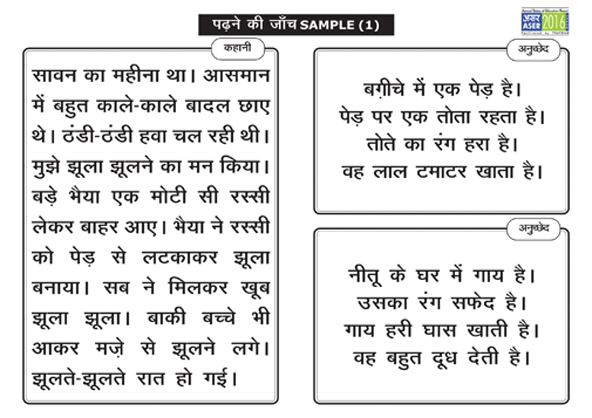
2. Children’s groups are made according to the basic assessment. Available teachers or instructors allocated to facilitate group activities and to guide children’s work.
1. Simple one-on-one assessment done to group Std. III, IV and V children by level rather than by grade.
4. Similar assessment used for tracking children’s progress, periodically and to guide onsite monitoring.

3. For each group there are a set of activities and materials appropriate for their level.
Children learn in groups and also individually. Teachers or instructors do activities with groups.
As children make progress they move into the next group.
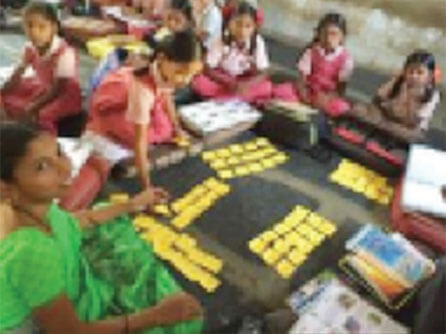
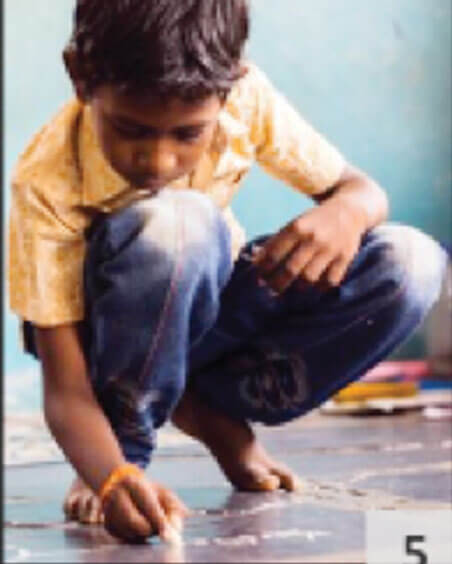
1. Simple one-on-one assessment done to group Std. III, IV and V children by level rather than by grade.

2. Children’s groups are made according to the basic assessment. Available teachers or instructors allocated to facilitate group activities and to guide children’s work.
3. For each group there are a set of activities and materials appropriate for their level.
Children learn in groups and also individually. Teachers or instructors do activities with groups.
As children make progress they move into the next group.


4. Similar assessment used for tracking children’s progress, periodically and to guide onsite monitoring.

To be effective, the “Teaching at the Right Level” approach needs to be embedded in a larger eco-system whose elements are aligned to support and ensure learning for all children. Here are the main features of the school system that need to be changed to ensure that learning for all is possible.
| Business as Usual | Teaching aT THE RIGHT LEVEL | |||
|---|---|---|---|---|
| GOAL | Goal is to complete the grade level textbook. | Clearly articulated goals for basic reading and arithmetic. Goal is to ensure basic foundational skills for all. | ||
| TRAINING & MENTORING | Resource persons as trainers. Weak ongoing, on-site support by those who have trained teachers. | "Leaders of practice" created via "learning by doing. Select Government cadre "practice" the approach for 20-25 days and taste " success, then train teachers and provide ongoing on-site monitoring and mentoring. | ||
| GROUPING | Full class teaching at grade level. | Children grouped by level rather than by grade for instruction. Children move quickly from one group to next as they progress. “Teaching at the Right Level”. | ||
| TEACHING & ACTIVITIES | “Chalk and talk”. Textbook driven. Teaching to the "top of the class" | Simple framework of daily activities that can be adapted as children progress. (CAMaL – Combined Activities for Maximized Learning). Activities in big groups, small groups and individually. | ||
| ASSESSMENT MEASUREMENT DATA REVIEW | Pen-paper grade level test done at the beginning of a phase and at the end. | Simple quick one-on-one oral assessment used at start for grouping. Similar assessment used periodically to track progress. Data discussion and review at all levels. Aggregate school or class-level data used to propel program not child-wise data. | ||
Big change is possible
Today Pratham’s “TaRL” approach is implemented in two ways – directly by Pratham instructors through “Learning Camps” or as part of a Pratham-government partnership programs where government teachers implement TaRL as part of the school day. In the direct model, Pratham instructors run “Learning Camps”, 30-50 days of instruction (3 to 5 camps of 10 days each), for about 3 hours a day. In the partnership model, government teachers use this approach over a longer period in the school year (four to six months) with dedicated time for 1-2 hours a day.


Here is an example of learning improvement seen in the 2017-18 Pratham-Goverment of Karnataka Partnership Program for Std. IV & V:

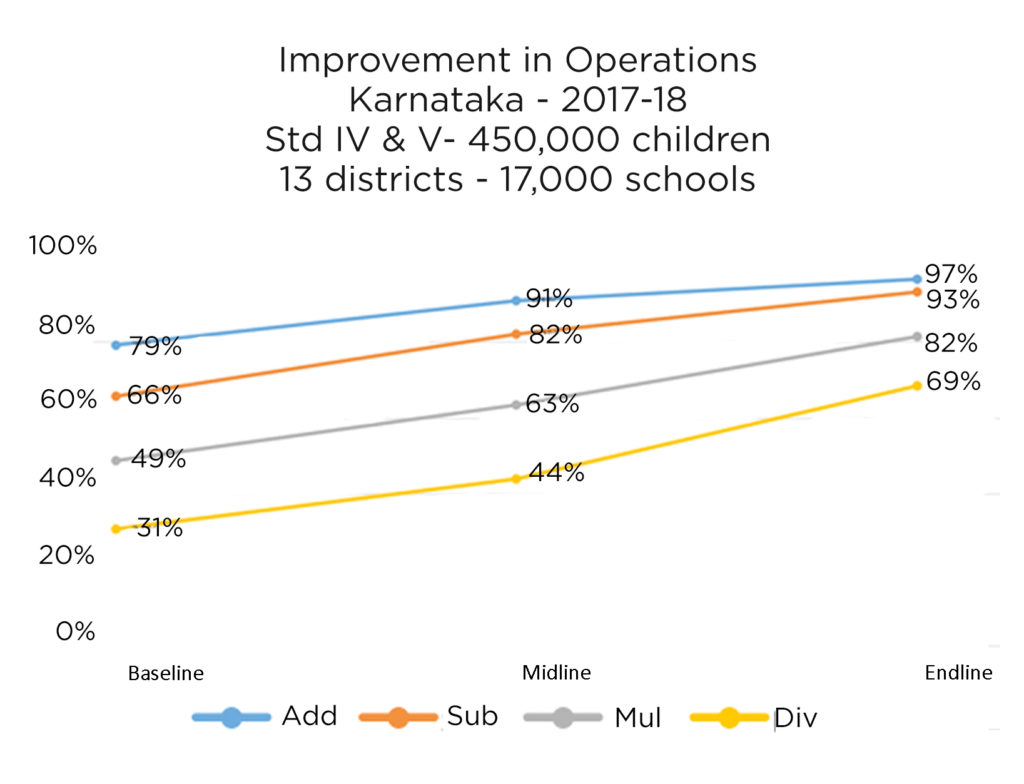
In the 2018-19 school year, Pratham is partnering with several state governments to help children acquire foundational skills. These states include Uttar Pradesh, Punjab, Himachal Pradesh, Bihar, Madhya Pradesh, Karnataka, Jammu and Kashmir and in some districts for Andhra Pradesh, Chhattisgarh and Jharkhand and West Bengal.